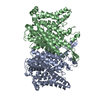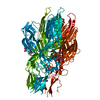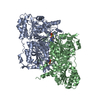[English] 日本語
 Yorodumi
Yorodumi- EMDB-31579: Cryo-EM structure of CCHFV envelope protein Gc in postfusion conf... -
+ Open data
Open data
- Basic information
Basic information
| Entry | Database: EMDB / ID: EMD-31579 | |||||||||
|---|---|---|---|---|---|---|---|---|---|---|
| Title | Cryo-EM structure of CCHFV envelope protein Gc in postfusion conformation | |||||||||
 Map data Map data | ||||||||||
 Sample Sample |
| |||||||||
 Keywords Keywords | CCHFV / envelope protein / postfusion / Bunyavirus / VIRAL PROTEIN | |||||||||
| Function / homology |  Function and homology information Function and homology informationhost cell Golgi membrane / clathrin-dependent endocytosis of virus by host cell / host cell endoplasmic reticulum membrane / fusion of virus membrane with host endosome membrane / viral envelope / virion attachment to host cell / virion membrane / membrane Similarity search - Function | |||||||||
| Biological species |  Crimean-Congo hemorrhagic fever virus strain IbAr10200 Crimean-Congo hemorrhagic fever virus strain IbAr10200 | |||||||||
| Method | single particle reconstruction / cryo EM / Resolution: 2.8 Å | |||||||||
 Authors Authors | Li N / Rao G | |||||||||
| Funding support |  China, 1 items China, 1 items
| |||||||||
 Citation Citation |  Journal: Virol Sin / Year: 2022 Journal: Virol Sin / Year: 2022Title: Cryo-EM structure of glycoprotein C from Crimean-Congo hemorrhagic fever virus. Authors: Na Li / Guibo Rao / Zhiqiang Li / Jiayi Yin / Tingting Chong / Kexing Tian / Yan Fu / Sheng Cao /  Abstract: Crimean-Congo hemorrhagic fever virus (CCHFV) is a causative agent of serious hemorrhagic diseases in humans with high mortality rates. CCHFV glycoprotein Gc plays critical roles in mediating virus- ...Crimean-Congo hemorrhagic fever virus (CCHFV) is a causative agent of serious hemorrhagic diseases in humans with high mortality rates. CCHFV glycoprotein Gc plays critical roles in mediating virus-host membrane fusion and has been studied extensively as an immunogen. However, the molecular mechanisms involved in membrane fusion and Gc-specific antibody-antigen interactions remain unresolved largely because structural information of this glycoprotein is missing. We designed a trimeric protein including most of the ectodomain region of Gc from the prototype CCHFV strain, IbAr10200, which enabled the cryo-electron microscopy structure to be solved at a resolution of 2.8 Å. The structure confirms that CCHFV Gc is a class II fusion protein. Unexpectedly, structural comparisons with other solved Gc trimers in the postfusion conformation revealed that CCHFV Gc adopted hybrid architectural features of the fusion loops from hantaviruses and domain III from phenuiviruses, suggesting a complex evolutionary pathway among these bunyaviruses. Antigenic sites on CCHFV Gc that protective neutralizing antibodies target were mapped onto the CCHFV Gc structure, providing valuable information that improved our understanding of potential neutralization mechanisms of various antibodies. | |||||||||
| History |
|
- Structure visualization
Structure visualization
| Movie |
 Movie viewer Movie viewer |
|---|---|
| Structure viewer | EM map:  SurfView SurfView Molmil Molmil Jmol/JSmol Jmol/JSmol |
| Supplemental images |
- Downloads & links
Downloads & links
-EMDB archive
| Map data |  emd_31579.map.gz emd_31579.map.gz | 167.3 MB |  EMDB map data format EMDB map data format | |
|---|---|---|---|---|
| Header (meta data) |  emd-31579-v30.xml emd-31579-v30.xml emd-31579.xml emd-31579.xml | 9.3 KB 9.3 KB | Display Display |  EMDB header EMDB header |
| Images |  emd_31579.png emd_31579.png | 129.9 KB | ||
| Filedesc metadata |  emd-31579.cif.gz emd-31579.cif.gz | 5.1 KB | ||
| Archive directory |  http://ftp.pdbj.org/pub/emdb/structures/EMD-31579 http://ftp.pdbj.org/pub/emdb/structures/EMD-31579 ftp://ftp.pdbj.org/pub/emdb/structures/EMD-31579 ftp://ftp.pdbj.org/pub/emdb/structures/EMD-31579 | HTTPS FTP |
-Validation report
| Summary document |  emd_31579_validation.pdf.gz emd_31579_validation.pdf.gz | 511.2 KB | Display |  EMDB validaton report EMDB validaton report |
|---|---|---|---|---|
| Full document |  emd_31579_full_validation.pdf.gz emd_31579_full_validation.pdf.gz | 510.8 KB | Display | |
| Data in XML |  emd_31579_validation.xml.gz emd_31579_validation.xml.gz | 6.9 KB | Display | |
| Data in CIF |  emd_31579_validation.cif.gz emd_31579_validation.cif.gz | 8 KB | Display | |
| Arichive directory |  https://ftp.pdbj.org/pub/emdb/validation_reports/EMD-31579 https://ftp.pdbj.org/pub/emdb/validation_reports/EMD-31579 ftp://ftp.pdbj.org/pub/emdb/validation_reports/EMD-31579 ftp://ftp.pdbj.org/pub/emdb/validation_reports/EMD-31579 | HTTPS FTP |
-Related structure data
| Related structure data |  7fgfMC M: atomic model generated by this map C: citing same article ( |
|---|---|
| Similar structure data |
- Links
Links
| EMDB pages |  EMDB (EBI/PDBe) / EMDB (EBI/PDBe) /  EMDataResource EMDataResource |
|---|
- Map
Map
| File |  Download / File: emd_31579.map.gz / Format: CCP4 / Size: 178 MB / Type: IMAGE STORED AS FLOATING POINT NUMBER (4 BYTES) Download / File: emd_31579.map.gz / Format: CCP4 / Size: 178 MB / Type: IMAGE STORED AS FLOATING POINT NUMBER (4 BYTES) | ||||||||||||||||||||||||||||||||||||||||||||||||||||||||||||||||||||
|---|---|---|---|---|---|---|---|---|---|---|---|---|---|---|---|---|---|---|---|---|---|---|---|---|---|---|---|---|---|---|---|---|---|---|---|---|---|---|---|---|---|---|---|---|---|---|---|---|---|---|---|---|---|---|---|---|---|---|---|---|---|---|---|---|---|---|---|---|---|
| Projections & slices | Image control
Images are generated by Spider. | ||||||||||||||||||||||||||||||||||||||||||||||||||||||||||||||||||||
| Voxel size | X=Y=Z: 0.61 Å | ||||||||||||||||||||||||||||||||||||||||||||||||||||||||||||||||||||
| Density |
| ||||||||||||||||||||||||||||||||||||||||||||||||||||||||||||||||||||
| Symmetry | Space group: 1 | ||||||||||||||||||||||||||||||||||||||||||||||||||||||||||||||||||||
| Details | EMDB XML:
CCP4 map header:
| ||||||||||||||||||||||||||||||||||||||||||||||||||||||||||||||||||||
-Supplemental data
- Sample components
Sample components
-Entire : CCHFV envelope protein Gc
| Entire | Name: CCHFV envelope protein Gc |
|---|---|
| Components |
|
-Supramolecule #1: CCHFV envelope protein Gc
| Supramolecule | Name: CCHFV envelope protein Gc / type: complex / ID: 1 / Parent: 0 / Macromolecule list: all |
|---|---|
| Source (natural) | Organism:  Crimean-Congo hemorrhagic fever virus strain IbAr10200 Crimean-Congo hemorrhagic fever virus strain IbAr10200 |
-Macromolecule #1: Glycoprotein C
| Macromolecule | Name: Glycoprotein C / type: protein_or_peptide / ID: 1 / Number of copies: 3 / Enantiomer: LEVO |
|---|---|
| Source (natural) | Organism:  Crimean-Congo hemorrhagic fever virus strain IbAr10200 Crimean-Congo hemorrhagic fever virus strain IbAr10200Strain: IbAr10200 |
| Molecular weight | Theoretical: 65.809711 KDa |
| Recombinant expression | Organism:  |
| Sequence | String: MKNLLNSTSL ETSLSIEAPW GAINVQSTYK PTVSTANIAL SWSSVEHRGN KILVSGRSES IMKLEERTGI SWDLGVEDAS ESKLLTVSV MDLSQMYSPV FEYLSGDRQV GEWPKATCTG DCPERCGCTS STCLHKEWPH SRNWRCNPTW CWGVGTGCTC C GLDVKDLF ...String: MKNLLNSTSL ETSLSIEAPW GAINVQSTYK PTVSTANIAL SWSSVEHRGN KILVSGRSES IMKLEERTGI SWDLGVEDAS ESKLLTVSV MDLSQMYSPV FEYLSGDRQV GEWPKATCTG DCPERCGCTS STCLHKEWPH SRNWRCNPTW CWGVGTGCTC C GLDVKDLF TDYMFVKWKV EYIKTEAIVC VELTSQERQC SLIEAGTRFN LGPVTITLSE PRNIQQKLPP EIITLHPRIE EG FFDLMHV QKVLSASTVC KLQSCTHGVP GDLQVYHIGN LLKGDKVNGH LIHKIEPHFN TSWMSWDGCD LDYYCNMGDW PSC TYTGVT QHNHASFVNL LNIETDYTKN FHFHSKRVTA HGDTPQLDLK ARPTYGAGEI TVLVEVADME LHTKKIEISG LKFA SLACT GCYACSSGIS CKVRIHVDEP DELTVHVKSD DPDVVAASSS LMARKLEFGT DSTFKAFSAM PKTSLCFYIV EREHC KSCS EEDTKKCVNT KLEQPQSILI EHKGTIIGKQ NSTCTAKSRG SGGMKQIEDK IEEILSKIYH IENEIARIKK LIGEGS GGS RGPFEGKPIP NPLLGLDSTR TGHHHHHH UniProtKB: Envelopment polyprotein |
-Experimental details
-Structure determination
| Method | cryo EM |
|---|---|
 Processing Processing | single particle reconstruction |
| Aggregation state | particle |
- Sample preparation
Sample preparation
| Buffer | pH: 7.4 |
|---|---|
| Vitrification | Cryogen name: ETHANE |
- Electron microscopy
Electron microscopy
| Microscope | JEOL CRYO ARM 300 |
|---|---|
| Image recording | Film or detector model: GATAN K3 (6k x 4k) / Average electron dose: 48.0 e/Å2 |
| Electron beam | Acceleration voltage: 300 kV / Electron source:  FIELD EMISSION GUN FIELD EMISSION GUN |
| Electron optics | Illumination mode: FLOOD BEAM / Imaging mode: BRIGHT FIELD |
- Image processing
Image processing
| Startup model | Type of model: NONE |
|---|---|
| Final reconstruction | Resolution.type: BY AUTHOR / Resolution: 2.8 Å / Resolution method: FSC 0.143 CUT-OFF / Software - Name: cryoSPARC / Number images used: 187292 |
| Initial angle assignment | Type: NOT APPLICABLE |
| Final angle assignment | Type: NOT APPLICABLE |
 Movie
Movie Controller
Controller











 Z (Sec.)
Z (Sec.) Y (Row.)
Y (Row.) X (Col.)
X (Col.)





















